CBT Exam 2
1/46
There's no tags or description
Looks like no tags are added yet.
Name | Mastery | Learn | Test | Matching | Spaced |
|---|
No study sessions yet.
47 Terms
Core Belief
Core Beliefs are:
Fundamental
inflexible
absolute
generalized beliefs
Core beliefs:
The central ideas about self and the world
Inaccurate or unhelpful core beliefs can have a profound effect on a person’s self-concept, sense of self-efficacy, and continued vulnerability to pathology
MOST CENTRAL, FUNDAMENTAL BELIEFS ABOUT OURSELVES, OTHERS, AND THE WORLD
Absolute and rigid beliefs (+ or ‐) in 1‐2 words
example: “I’m worthless.”
May result in biases in attention, information processing, and memory. Not necessarily accurate or helpful
Intermediate Beliefs
Attitudes, rules, or assumptions
Stem from core beliefs
Fuel automatic thoughts
Examples of dysfunctional intermediate beliefs:
“To be accepted, I should always please others.”
“I should be excellent at everything I do to be considered adequate.”
“It is best to have as little as possible to do with people.”
Schemas
ways in which we view the world that are acquired over time
rules that give us shortcuts
Deep-rooted, cognitive frameworks that organize our beliefs, memories, and emotions about ourselves and others
Schemas are more flexible, and core beliefs are rigid
Schemas are shortcuts related to how we developed core beliefs
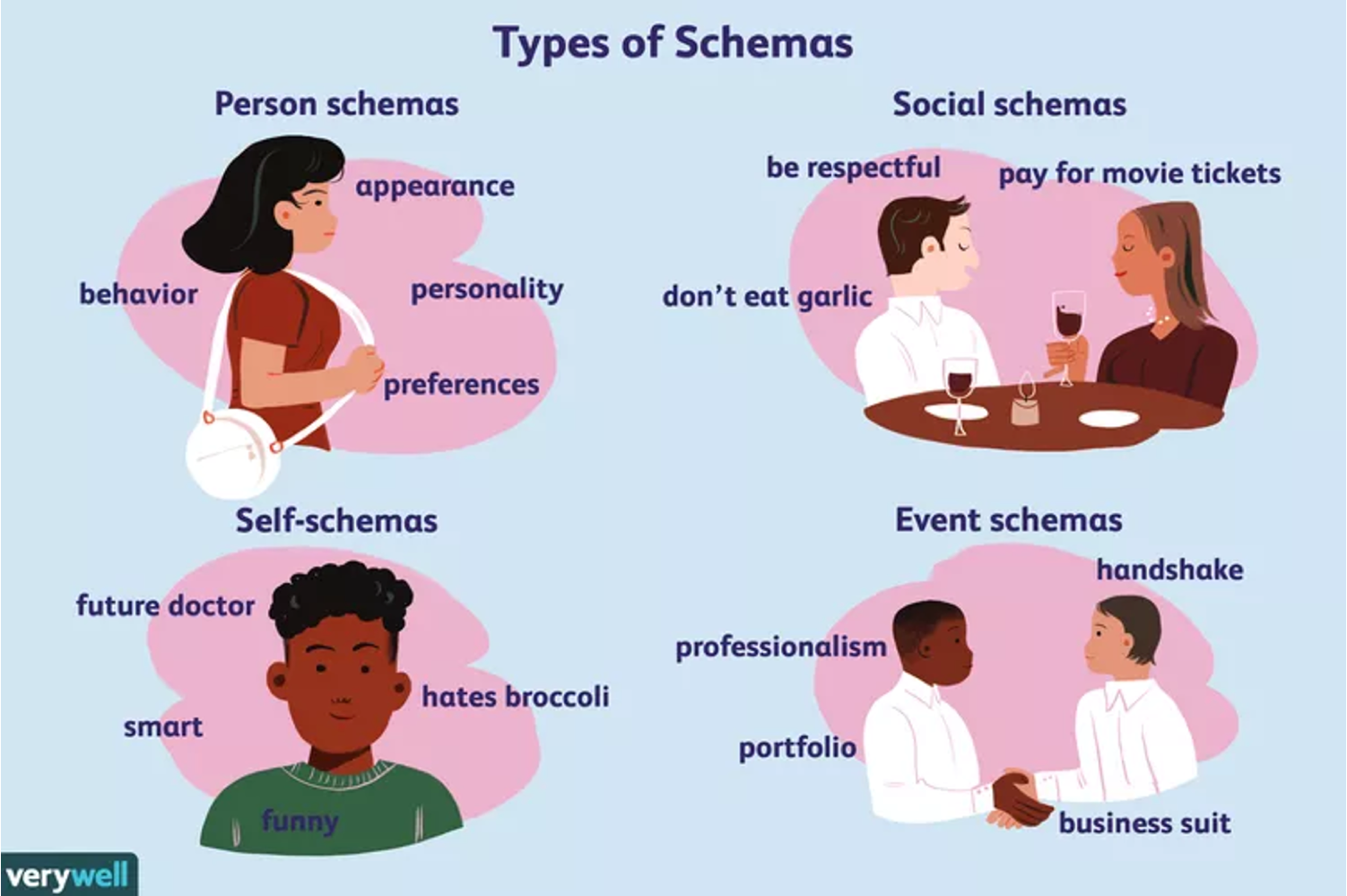
Why Modify Core Beliefs?
Adds flexibility/sense of self-kindness to a patient’s rules/assumptions
Decreases likelihood unhelpful or inaccurate automatic thoughts will be activated during stressful or challenging situations
Decreases extremity of unhelpful information processing biases
Core belief work is how we really attack automatic thoughts
How to identify core beliefs
Few patients will be able to articulate their core beliefs early in treatment
Automatic thoughts that provoke a great deal of affect have the potential to be core beliefs in and of themselves, or be a direct manifestation of a core belief
Look for themes in thought records across weeks and situations to begin to identify core beliefs
Be aware of common core beliefs for certain diagnoses
Downward Arrow Technique
Downward Arrow Technique
Repeatedly ask about the meaning of situational automatic thoughts until you arrive upon a core belief, whose meaning is so fundamental that there is no additional meaning associated with it.
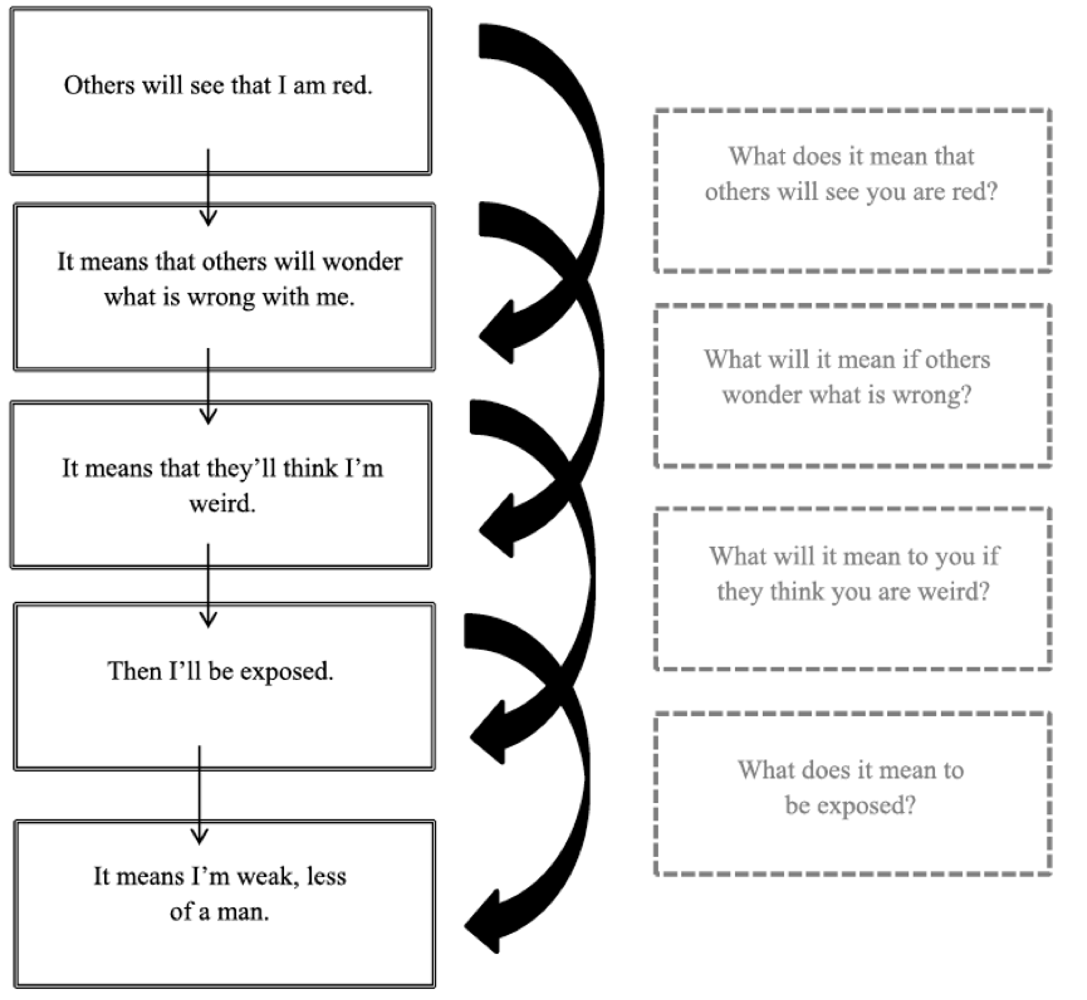
Modifying Core Beliefs Options
Option 1: Operationalize the components that make up the core belief → define it. Make them aware. Often buy in when you came at belief together
Option 2: Examine the Evidence → What supports/doesn’t.
Through information processing biases → they were probably only looking at data that supports core belief/discounting others
Option 3: Restructuring early memories → early memories have an effect on core beliefs.
New perspective, not changing memories just looking at the memories in a different way than you had before
Option 4: Advantages- Disadvantages analysis → we have new core belief and an old one. What are the advantages and disadvantages of both
Step 5: Behavioral Experiments →
For example, act as if your core belief is inaccurate and the new one is accurate
Ex: Smiling at strangers with social anxiety
Step 6 Example: “Acting as if”
Specific type of behavioral experiment. Patients behave in a manner consistent with a new, healthier belief (even if they are not fully invested in the new belief) and evaluate the effects of this new belief
Questions:
What were the effects on my mood (e.g., happier?, less anxious?)
How did others respond to me?
What negative consequences came from my acting “as if”?
What positive consequences came from my acting “as if”?
Cultural Responsiveness
Cultural effectiveness (the what)
starting to recognize whether the treatments available are effective across cultures
Cultural humility (the how)
can’t all have cultural competence
Cultural effectiveness is about acquiring knowledge and skills to interact effectively across cultures, while cultural humility is a lifelong, self-reflective process of examining one's own biases and power dynamics. Effectiveness is a goal with a focus on learning about others, whereas humility is a mindset focused on self-critique and continuous learning.
What is ACT?
Acceptance and Commitment Therapy Action-oriented approach and related to CBT
Clients learn to stop avoiding, denying, and struggling with their inner emotions
Instead accept these feelings
Developed in the 1980s by Steven Hayes, PhD
"We as a culture seem to be dedicated to the idea that ‘negative’ human emotions need to be fixed, managed, or changed—not experienced as part of a whole life. We are treating our own lives as problems to be solved as if we can sort through our experiences for the ones we like and throw out the rest," Steven Hayes, PhD

ACT vs CBT
CBT → goal: no symptoms, goals shaped from symptoms and therapy.
changing, disputing thoughts
ACT → goal: valued life, individual values shape the goal, might not necessarily be symptom-free
accepting thoughts
both:
believe experiences come from maladaptive thought but how we go about dealing with these thoughts is different
target improvement in life
use behavior strategies, emphasize a collaborative relationship
have relationship building, didactic, experiential learning, behavioral intervention/activation, homework
focus on the present and future
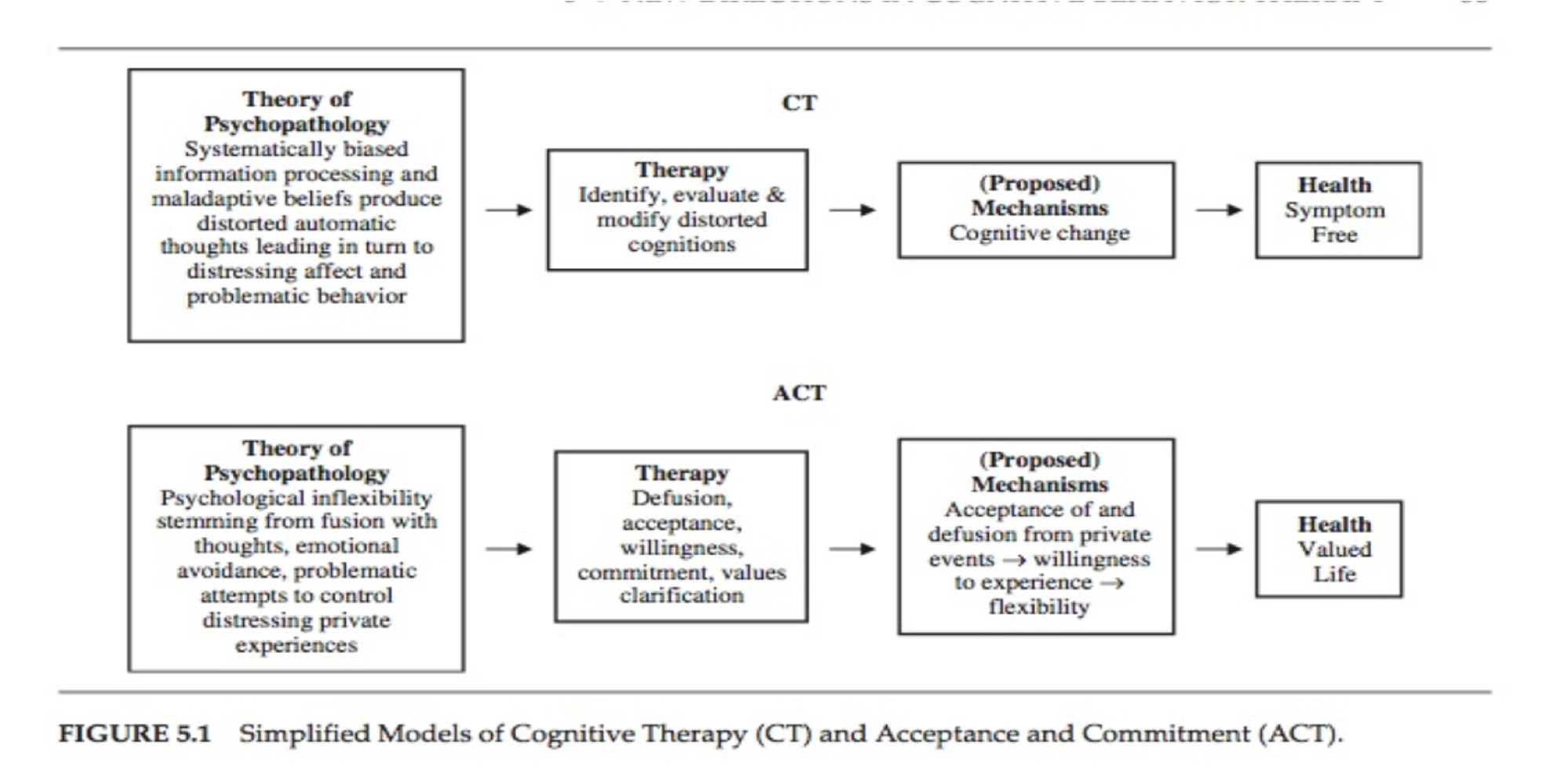
Hexaflex!!
Split into 2 chunks
Acceptance and Mindfulness Processes
Contact with the Present Moment
Acceptance
Defusion
Self as Context
Commitment and Behavior Changes
Contact with the Present Moment
Values
Committed Action
Self as Context
all connected and move toward the goal of psychological flexibility
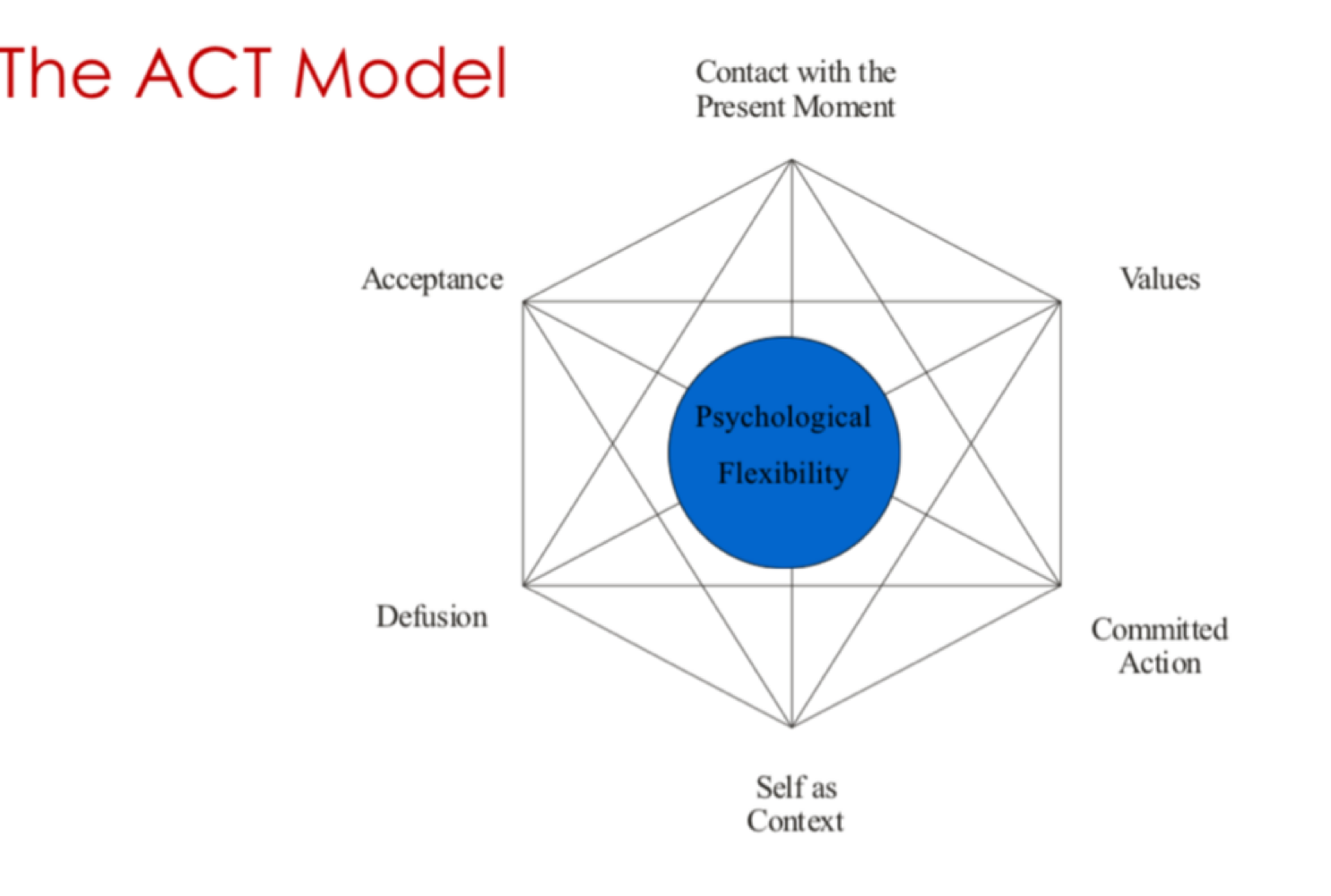
6 Components of ACT Forman and Herbert
Aims to increase psychological acceptance of subjective experiences (e.g., thoughts and feelings) and decrease experiential avoidance
Increase psychological awareness of the present moment
Teaches patients to defuse from subjective experiences, particularly thoughts
Decrease focus on and attachment to the conceptualized self
Values clarification
Committed Action
Experiential Avoidance
Avoiding internal experiences
Experiential avoidance (EA), or the unwillingness to remain in contact with distressing internal experiences along with the attempts to control or avoid distressing internal experiences, has been associated with a range of psychopathological symptoms across a range of clinical presentations of anxiety and fear
Creative Hopelessness
You’ve tried just about everything to feel better, get rid of negative emotions, etc...
“Gold medal” effort
Could simply “try harder.” But how likely is that to work?
What if your experience is valid? What if it won’t work because it can’t work?
Man in the Hole Metaphor
It’s not about how hard you’re working if you’re working at the wrong thing
Tug of War with Monster
Man in the Hole
You’re stuck in a hole with the nicest shovel ever, but, that’s not the right tool to get out
Creative Hopelessness metaphor to increase buy-in
Control as the Problem
Why do you keep trying to dig out
control/working hard works in other places (studying/practicing…)
it works for others
you are told it should work
It can often work in short term but not long term
The implications of creative hopelessness:
Cognitive and behavioral strategies designed to control our internal experience are unlikely to be effective
Control strategies are limiting
if you focus too much on one thing, we miss other options that could work

Informed Consent for ACT
have to be prepared to feel worse before you feel better
might have some distress but ultimatley it’ll be good for your health and feeling betteryour
it’s like going to the dentist
Acceptance
The alternative to controlling and fighting internal negative experiences is to accept
Chocolate Cake Metaphor
The more I tell you not to think about something, the harder it is
Negative reinforcement of experience avoidance
polygraph metaphor (gun to head, if you feel nervous, you will get shot)
How ridiculous it is to try to control our thoughts/feelings
The more you try to control, the more your brain is working and not doing other things
manufacture joy → you can try to fight a feeling by telling yourself you’re not upset, but you won’t win
Are you willing?
Not because you want or like it
Not because you’ve given up hope that it will get any better
But instead, to openly allow the momentary pain to end the long-term suffering?
The hidden choices
Give up “direct control” of your thoughts and emotions to gain control of your life
Allow yourself to experience all emotions, so you can also experience “good” emotions
Acceptance as the Alternative
Tug of War with a Monster
creative hopelessness
our job is not to win tug of war → goal is to drop the rope, let go of the rope
the monster might still be there, screaming on the other side but what’s the advantage of not holding the rope anymore?
you can do something else, don’t have to focus energy on the rope
gives you the freedom to live a valued life, do things that don’t have to do with the monster
Acceptance of Difficult Content
Giving up the control agenda means:
accepting the inevitability of distress; and
a willingness to experience that distress in the service of living a valued life
Psychological Acceptance
The ability and willingness to endure/tolerate aversive internal experiences
Learning to accept the presence of uncomfortable internal experiences
Engaging in behaviors even when they produce internal discomfort
Willingness
accept distress
active, not passive
Is a choice (not a feeling/belief)
an action (doing, not trying / a jump, not a step)
is always in the service of our goals / values and recovery (it’s not a resignation or giving up, it’s just a different strategy)
The Scales Metaphor
anxiety and willingness on different sides of a scale. We can’t control our anxiety but we can control our willingness
if willingness is 0, your anxiety will never move. You can control your willingness and no matter what your anxiety will move
Willingness Worsheet
how willing were you throughout the week to experience certain psychological distress?
Can willingness alter the frequency/intensity of internal experiences?
Short answer: Yes
In the long-term, in an overall average kind of way
But, “rogue waves” and the inability to ever take away all negative feelings
Negative experiences are a part of your life
We can tell clients this directly, but...
“trying to pick up the rope”
The second you see the goal as taking away your distress, it changes to a goal-focused agenda
don’t want them to keep trying to control
Psychological Acceptance: Distress Tolerance
Uncoupling
Converting “but” language into “and” language
Willingness:
Transforming “only if” statements to “even if” statements
Pattern smashing
Dealing with Dirty Distress
But/and
Type of distress tolerance. Uncoupling exercises
both distress and action can exist at the same time
Example:
I would eat all my meals and snacks today but I am afraid of gaining weight
I will eat all my meals and snacks today and I am afraid of gaining weight
Even if, only if
Has to do with willingness
Example:
I will get go to the social event only if I don’t feel too tired or depressed
I will get go to the social event even if I feel tired and depressed.
once someone starts noticing how distress is impairing their ability to engage in other areas, they can start replacing it
Dirty Distress
distress that you’re feeling distressed
the goal is to shed the 2nd layer of distress and get rid of judgement
clean distress”: experiencing the pure distress in the present moment
(“I’m sad, this is unpleasant”; “I am in pain”)
“Dirty distress”:
additional feelings about your feelings (e.g. irritated about being sad - “I shouldn’t feel sad – I should just get on with it”).
Cognitive Defusion
Getting distance
Our minds are so smooth that we barely even notice it’s working...we get caught up in products of our thinking without noticing the process.
You can think of this as the first part of Defusion in ACT – the idea of observing and separating from internal experiences
We are so fused (stuck) with our thoughts, the fusion makes us believe they are true
Recognizing that an internal experience is an internal experience, e.g., labeling and describing thoughts as thoughts, emotions as emotions, etc.
Looking at internal experiences, rather than from internal experiences
notice automatcity of thoughts → fast, happens all the time (Mary had a little … lamb)
Cognitive Fusion and Defusion
cognitive fusion → you believe your thoughts
believing the literal contents of the mind, so one become fused w/ thoughts
cognitive defusion → opposite, getting distance and separating yourself from your thoughts
“Disentangling people from their minds is one of the main aims of ACT”
Cognitive Defusion Exercises
Observe, Describe, Balance
Learning to get distance from and Label Thoughts, Feelings, and Physical Sensations
Balancing Inner and Outer Wisdom
Word Repetition → when you say the word over and over it loses it’s meaning. The word is just a word, we give it meaning
Leaves on a Stream
Present Moment Awareness
ACT & CBT are present and future focused
nonjudgemental awareness of the present moment
A state of full, open, and non-judgmental awareness of your current experience—both internal (thoughts, feelings) and external (sights, sounds, sensations).
The goal: To be fully engaged in what is happening right now, rather than being lost in rumination about the past or worry about the future.
How do cognitive defusion and present moment awareness work together
Defusion helps you stop being swept away by your thoughts, and contact with the present is the result — a direct, sensory experience of here and now
Shifting attention back to the present moment
Ruminations can feel true, but our thoughts about life are not life.
Our mind can tell us a mouse is a monster. Your mind can keep you safe, but it can also overreact
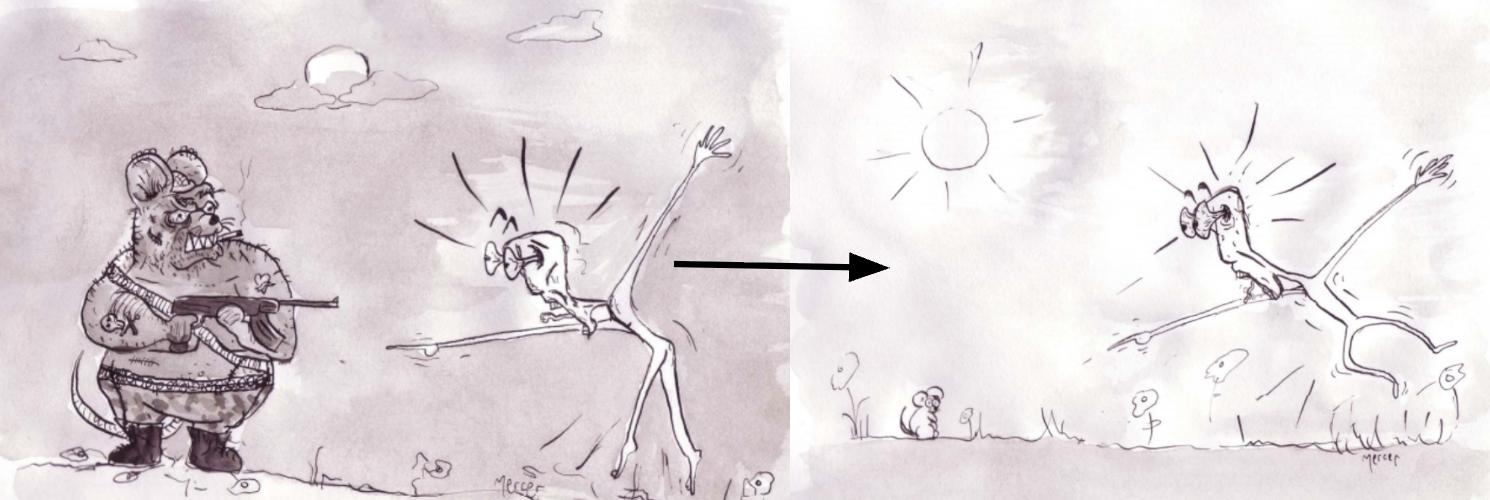
Mindful Awareness Skills
contact with the present moment linked with mindful awareness skills by using mindfulness to be present, engage senses, and observe thoughts and feelings in a nonjudgmental way,
Observe, Describe, Balance: Increasing awareness of emotions, physical sensations, and thoughts
shifting attention back to present
Mindful Decision Making:
Each time you notice an external cue, stop and think so you can choose your behavior
Slowing the decision-making process can increase awareness and allow you to make more intentional choices
Awareness of immediate experiences
Internal : thoughts, feelings, desires, hunger, cravings
“External”: sounds, sights, smells
Stop, think
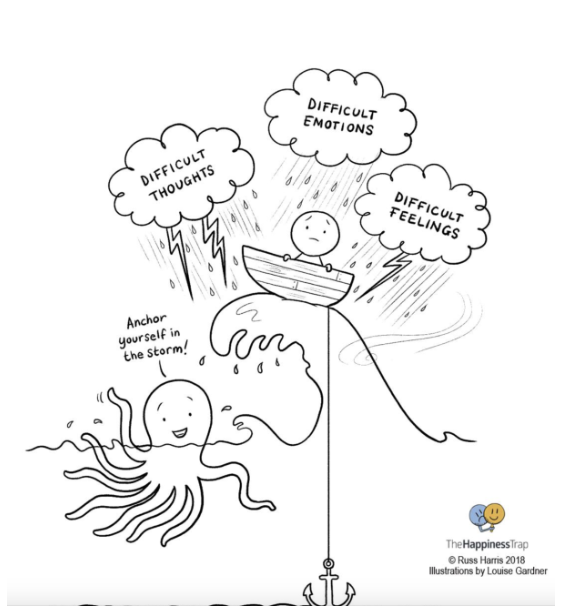
Radical Acceptance
the practice of completely accepting reality as it is, without judgment or resistance, to reduce suffering
You’re not giving up hope but giving yourself strength toward it
It's not about approval or giving up, but rather acknowledging the facts without judgment, which then opens the door to finding a better way forward.
Self-as-Concept
2 sides
Self as Content → problem
Self as Context → solution
Self-as-Content
The Story of Me
Organized into cognitive networks coherent across time and situations
Well-elaborated
Multi-layered
Once we have a story, we don’t like how it feels to be
“wrong” about our story: e.g. cognitive dissonance
When we take our stories about ourselves to be literally true, we guard and defend them WITH OUR LIVES.
We work to construct our worlds in a way that confirms the truth of our self-labels.
Like a documentary
our mind is telling you a story but the story is not you.
Usually true to a degree, but not the whole truth
Scenes are selected to maintain the truth and coherence of the story
Common treatment interfering conceptualized selves
Over attachment to:
Illness as part of identity
Victimhood
Likability
Everyone else is the problem, not me
Busyness as a virtue
Caretaker roles
Success/things come easy to me
Self-as-Context
This approach involves understanding that one's identity is distinct from thoughts and feelings, fostering a stable sense of self amidst changing internal experiences. This perspective helps individuals maintain a consistent sense of self-identity, even as their thoughts and emotions fluctuate
The sense of self as perspective
You are a person separate from your story
Your story can and should grow and change over time
Not threatened by aversive content
Facilitates willingness, compassion, intimacy
Chess example
make space for both positive and negative pieces, but we’re not involved in the game/fighting. We don’t want to be stuck plaing ches,s but we want to be the chess board. I am more than any individual piece.
We can invest time/effort in acting like the person we want to be instead of battling our thoughts and feelings

Values
Values
What are the things important to you
freely chosen
might be similar to you as the therapist, but it’s ok if they’re totally different
like CBT → you are the expert in yourself, only YOU can say what’s important to you
Tombstone or 80th birthday
Values-Based-Decision-Making Skills
Values-Based-Decision-Making Skills
Values Clarity
Building a Valued Life
Values-Based Decision Making
Values Awareness
Up Votes and Down Votes
Using Values to Address Negative Mood
Addressing Competing Values
Values-Based Decision-Making
Behaviors as choices
Consider options/values/goals
Engage in behavior congruent with values
If you rank values and recognize them, balance them, and understand how they shift, you can use your values as a framework for decisions
Up/Down Vote for Values
Recognize that every decision you make is a vote up or down for your values
Every decision goes toward (up vote) or against (down vote) for a value
shift away from psychopathology, instead, how do we work toward life that we want
Using Values to Address “Negative” Feelings
Unpleasant feelings can be an important signal that we are about to make a decision about how to behave or act.
Negative feelings can be cues that we are going away from our values
In this way, unpleasant feelings are an important cue that we should use a values-based decision-making skill.
we let values lead our motivations
we make decisions based off our values not our feelings
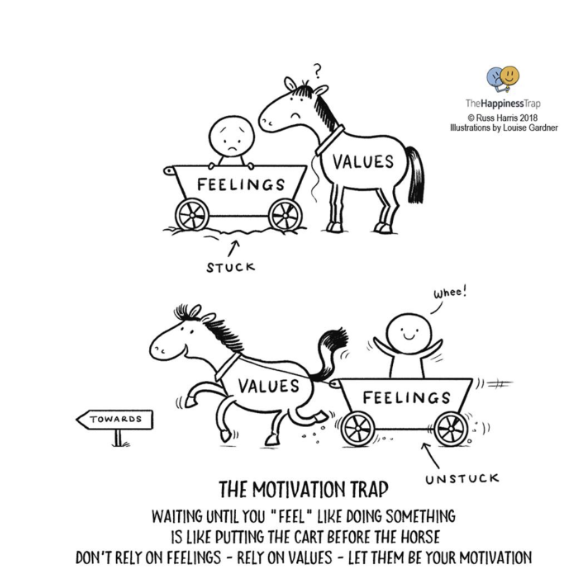
Barriers to Living a Valued Life
Why is it so difficult to engage in some behaviors, even when they are consistent with our values?
you need to do the work, make decisions
easy to become complacent

Values Conflict
2 options:
can integrate values
In other words, we don’t always have to choose one value over the other – we can live by both.
can rank or prioritize values
what’s more important in the moment
Sometimes hard/impossible to make choice that is consistent with 2 values at the same time.
Consider which value is most important to act on (at the moment); prioritize that value
Don’t always default to same value!
Goals vs Values
Values → directions
goals → mile markers
Committed Action
Encourages taking concrete steps toward goals that are consistent with one's values, promoting perseverance and adaptability.
Setting specific, values-driven goals and pursuing them despite obstacles, thereby enhancing overall life satisfaction and achievement
Living in line with our values even when we have difficult thoughts and feelings
Homework
committed toward ACT even when raw and uncomfortable feelings can come up
Coin example → pain on one side and values on the other. You don’t get to throw away just the pain. If you care about this, that means the times you stray from your values will hurt. Have to take pain with you to go toward the goal